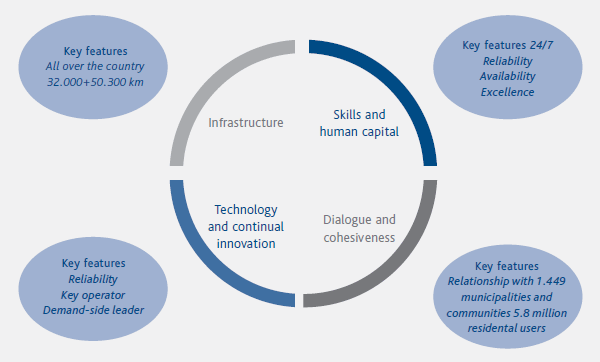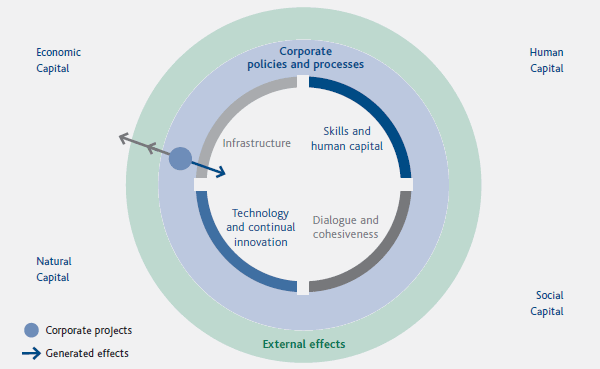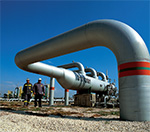
The subject of shared value is not intended to replace the sustainability measures in existence at the Company, but to support and enhance that aspect, from a standpoint of continuity and consistency with what is already in place. In an attempt to follow this approach in its operations, Snam has made a summary interpretative model, which has allowed the group to review its core and support processes from the standpoint of shared value.
SNAM’S ASSETS FOR VALUE CREATION

Snam’s assets
Every company is characterised by corporate assets, which represent levers for the creation of value. These are distinctive elements of each company, which represent the stock of internal capital, on the one hand, and, on the other, define the manoeuvring room for creating value, competing on the market and generating wealth. Snam has identified four fundamental assets which can broadly represent its core business.
Using these levers, Snam intends to interpret the subject of shared value.
Infrastructure
Snam works to achieve countrywide growth with infrastructure that is silent and invisible, wide-reaching and secure, and carries what is, in itself, already an asset for the country: energy with a reduced environmental impact. In addition, the investments made in recent years aimed at making Italy the hub of the Mediterranean place the Company amongst the most important players in the European economy.
Technology and continuous innovation
Due to the peculiarity of its business, Snam ranks as a multiplier of innovation on the domestic scene. A pioneer of many technological solutions, the Company indirectly furthers an offering of specific and cutting-edge services, preparing operating standards as an early adopter which are then made available nationwide.
Over the years, Snam has promoted a demand for new technology, striking up partnerships with high-ranking suppliers, in a path toward mutual growth.
Skills and human capital
Snam also provides its own services using specialised human capital capable of skilfully managing complex facilities and projects. This distinctive savoir faire is an example for the country as a whole.
This human capital is among the Company’s intangible assets and contributes to its success on a daily basis.
Dialogue and cohesion
Lastly, Snam holds significant relational capital, as it physically enters Italian homes via an indispensable service. Local relations and distribution throughout the peninsula, by means of local offices and broad-based skills, ensure a relationship of strong interrelation with the community. With some players, the group has dialogues and constant contact.
Snam is one of the few operators that provide uniform and universal service throughout Italy. For this reason, Snam can take on a key role in generating positive external effects for the community, from promoting lawfulness to creating widespread well-being, under the banner of transparency and inclusion.
Processes that generate value
The corporate assets are managed and guided by common policies which give rise to the processes that characterise the Company’s day-to-day operations, as well as the peculiar features of individual company functions. On the basis of the assets identified, the prevailing policies and processes are developed (summarised in the corporate Organisational Manual). In short, Snam develops projects, based on processes, aimed at maximising the potential for generating shared value.
SHARE VALUE MODEL

Local impacts

External effects become impacts if they have a significant effect on local assets.
To supplement its methodological approach, Snam has chosen to interpret local areas using the Four Capital Model, which identifies a capital inventory in the said local area, identified as four assets, conceptually mirroring the four assets described above in relation to the Company. The Four Capital Model, developed in connection with a broad-based European Union project in collaboration with other partners2, is used to support the measuring and planning of local public policies because it offers a summary measurement of the economic and social well-being of a given area. The underlying idea of the model is that four forms of capital go into making up the size of the “overall” capital, with respect to which a system’s sustainability can be measured.
The application of this model allows for “measuring” the quality of development processes and encourages an integrated approach in the formulation of strategies and programmes by decision-makers, helping to grasp the relevance of certain fundamental variables for balanced and lasting development. The local aspect of development is in fact a fundamental prerequisite for the well-being of communities: the economic, natural and social wealth of the reality in which we live depends on the sustainability of local growth processes.
“The Four Capital Model”
The “Four Capital Model” lends itself to discussion with representatives of local interests, to public presentations, to the identification of objectives and responsibilities, and to ex ante evaluation. The four areas of measurement taken into consideration by the methodology, with particular reference to a local area’s ability to be self-sustaining and grow in a balanced manner, can be summarised as follows:
economic capital: this is made up of what is traditionally considered as capital, i.e. all the resources available to produce goods and services, as well as wealth created and economic well-being. The indicators used to measure economic capital are: disposable income, real estate wealth, infrastructure, savings, credit, companies, production activities in different sectors, etc.
natural capital: besides traditional natural resources, such as water, land, air, energy and natural areas, natural capital includes pressure factors that can reduce the supply of such resources. The indicators used to measure natural capital are: air quality (e.g. CH4, NOx, COV, CO, PM10), CO2 emissions, waste production and management (e.g. urban waste, separated collection), land use, green areas, energy and gas consumption, anthropic pressure, etc.
human capital: this refers to the potential productivity of an individual and his/her state of health and well-being; it therefore includes health, education, experience and work skills. All of these elements contribute to development because they determine workforce productivity. Indicators used include: demographic trends, population structure, immigration, academic institutions, professional training, entrepreneurship and culture.
social capital: this refers to the concept of cohesiveness, cooperation and social well-being. Social capital is defined as a structure of relatively long-lasting relationships between people that are capable of encouraging cooperation and therefore of producing material and symbolic assets, like other forms of capital. This relationship structure is made up of formal and informal trust networks that stimulate reciprocity and cooperation. The indicators used are: personal assistance services, political participation, connections within the community, access to basic services, support for families, income disparities, and certain trust and social cohesiveness indicators.
A local area is deemed sustainable if the system’s overall capital endowment is not subject to decline.
2. The Four Capital Model was proposed and experimented with in the context of evaluating the sustainability of interventions financed by the European Union’s Structural Funds, in broad-based research commissioned from a network of European universities and research institutes by the Directorate-General for Regional Policy (DG REGIO) of the European Commission (DG REGIO EC, The contribution of the structural funds to sustainable development, Brussels, 2002).



